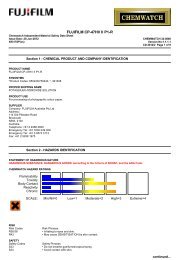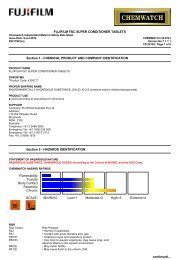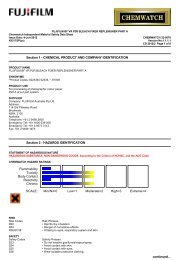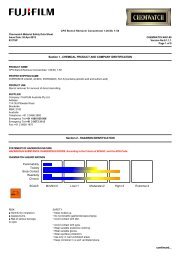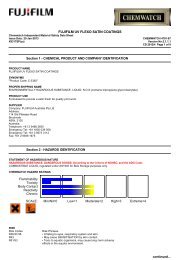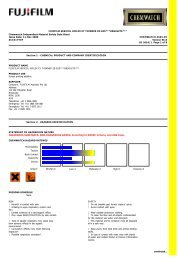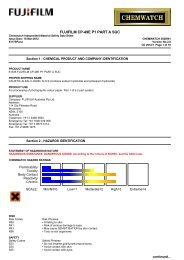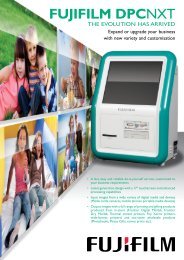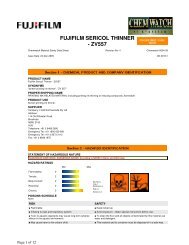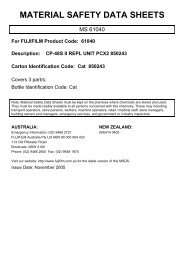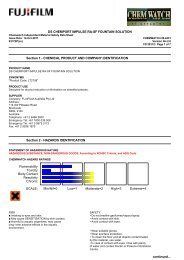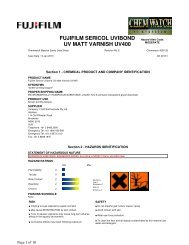Chemwatch MSDS Print - FUJIFILM Australia
Chemwatch MSDS Print - FUJIFILM Australia
Chemwatch MSDS Print - FUJIFILM Australia
You also want an ePaper? Increase the reach of your titles
YUMPU automatically turns print PDFs into web optimized ePapers that Google loves.
Fujifilm Sericol Plate And Roller Wash ZA302<strong>Chemwatch</strong> Material Safety Data SheetIssue Date: 15-Apr-2011 CHEMWATCH 4714-8C9317SCVersion No:4CD 2011/2 Page 1 of 8Section 1 - CHEMICAL PRODUCT AND COMPANY IDENTIFICATIONPRODUCT NAMEFujifilm Sericol Plate And Roller Wash ZA302PROPER SHIPPING NAMEFLAMMABLE LIQUID, N.O.S.(contains isopropanol)PRODUCT USEUsed in printing industry.SUPPLIERCompany: <strong>FUJIFILM</strong> <strong>Australia</strong> Pty LtdAddress:114 Old Pittwater RoadBrookvaleNSW, 2100<strong>Australia</strong>Telephone: +61 2 9466 2600Emergency Tel:+61 1800 039 008Emergency Tel:+61 3 9573 3112Fax: +61 2 9938 1975Section 2 - HAZARDS IDENTIFICATIONSTATEMENT OF HAZARDOUS NATUREHAZARDOUS SUBSTANCE. DANGEROUS GOODS. According to NOHSC Criteria, and ADG Code.CHEMWATCH HAZARD RATINGSFlammabilityToxicityBody ContactReactivityChronicSCALE: Min/Nil=0 Low=1 Moderate=2 High=3 Extreme=4RISK■ Highly flammable.■ Irritating to eyes and skin.■ May cause harm to the unbornchild.■ HARMFUL- May cause lung damageif swallowed.■ Vapours may cause drowsinessand dizziness.SAFETY• Keep locked up.• Keep away from sources of ignition. No smoking.• Do not breathe gas/fumes/vapour/spray.• Avoid contact with skin.• Avoid contact with eyes.• Wear suitable protective clothing.continued...
Fujifilm Sericol Plate And Roller Wash ZA302<strong>Chemwatch</strong> Material Safety Data SheetIssue Date: 15-Apr-2011 CHEMWATCH 4714-8C9317SCVersion No:4CD 2011/2 Page 2 of 8Section 2 - HAZARDS IDENTIFICATION• In case of insufficient ventilation, wear suitable respiratoryequipment.• Wear suitable gloves.• Wear eye/face protection.• Use only in well ventilated areas.• Keep container in a well ventilated place.• Avoid exposure - obtain special instructions before use.• Do not empty into drains.• To clean the floor and all objects contaminated by thismaterial, use water.• Keep container tightly closed.• This material and its container must be disposed of in a safeway.• Keep away from food, drink and animal feeding stuffs.• In case of contact with eyes, rinse with plenty of water andcontact Doctor or Poisons Information Centre.• This material and its container must be disposed of ashazardous waste.Section 3 - COMPOSITION / INFORMATION ON INGREDIENTSNAME CAS RN %isopropanol 67-63-0 >60propylene glycol monomethyl ether - mixture of isomers 107-98-2 10-30Section 4 - FIRST AID MEASURESSWALLOWED• If spontaneous vomiting appears imminent or occurs, hold patient's head down, lower than their hips to help avoid possibleaspiration of vomitus.• If swallowed do NOT induce vomiting.• If vomiting occurs, lean patient forward or place on left side (head-down position, if possible) to maintain open airway andprevent aspiration.• Observe the patient carefully.• Never give liquid to a person showing signs of being sleepy or with reduced awareness; i.e. becoming unconscious.EYE■ If this product comes in contact with the eyes:• Wash out immediately with fresh running water.• Ensure complete irrigation of the eye by keeping eyelids apart and away from eye and moving the eyelids by occasionally liftingthe upper and lower lids.• Seek medical attention without delay; if pain persists or recurs seek medical attention.• Removal of contact lenses after an eye injury should only be undertaken by skilled personnel.SKIN■ If skin contact occurs:• Immediately remove all contaminated clothing, including footwear.• Flush skin and hair with running water (and soap if available).• Seek medical attention in event of irritation.INHALED• If fumes or combustion products are inhaled remove from contaminated area.• Lay patient down. Keep warm and rested.• Prostheses such as false teeth, which may block airway, should be removed, where possible, prior to initiating first aidprocedures.• Apply artificial respiration if not breathing, preferably with a demand valve resuscitator, bag-valve mask device, or pocketmask as trained. Perform CPR if necessary.NOTES TO PHYSICIAN■ Treat symptomatically.For acute or short term repeated exposures to isopropanol:• Rapid onset respiratory depression and hypotension indicates serious ingestions that require careful cardiac and respiratorymonitoring together with immediate intravenous access.• Rapid absorption precludes the usefulness of emesis or lavage 2 hours post-ingestion. Activated charcoal and cathartics are notclinically useful. Ipecac is most useful when given 30 mins. post-ingestion.continued...
Fujifilm Sericol Plate And Roller Wash ZA302<strong>Chemwatch</strong> Material Safety Data SheetIssue Date: 15-Apr-2011 CHEMWATCH 4714-8C9317SCVersion No:4CD 2011/2 Page 3 of 8Section 4 - FIRST AID MEASURES• There are no antidotes.• Management is supportive. Treat hypotension with fluids followed by vasopressors.Any material aspirated during vomiting may produce lung injury. Therefore emesis should not be induced mechanically orpharmacologically.Section 5 - FIRE FIGHTING MEASURESEXTINGUISHING MEDIA• Alcohol stable foam.• Dry chemical powder.• BCF (where regulations permit).• Carbon dioxide.FIRE FIGHTING• Alert Fire Brigade and tell them location and nature of hazard.• May be violently or explosively reactive.• Wear breathing apparatus plus protective gloves.• Prevent, by any means available, spillage from entering drains or water course.FIRE/EXPLOSION HAZARD• Liquid and vapour are highly flammable.• Severe fire hazard when exposed to heat, flame and/or oxidisers.• Vapour may travel a considerable distance to source of ignition.• Heating may cause expansion or decomposition leading to violent rupture of containers.Combustion products include: carbon dioxide (CO2), other pyrolysis products typical of burning organic material.WARNING: Long standing in contact with air and light may result in the formationof potentially explosive peroxides.FIRE INCOMPATIBILITY• Avoid contamination with oxidising agents i.e. nitrates, oxidising acids, chlorine bleaches, pool chlorine etc. as ignition mayresult.HAZCHEM•3YEPersonal Protective EquipmentBreathing apparatus.Chemical splash suit.Section 6 - ACCIDENTAL RELEASE MEASURESMINOR SPILLS• Remove all ignition sources.• Clean up all spills immediately.• Avoid breathing vapours and contact with skin and eyes.• Control personal contact by using protective equipment.MAJOR SPILLS• Clear area of personnel and move upwind.• Alert Fire Brigade and tell them location and nature of hazard.• May be violently or explosively reactive.• Wear breathing apparatus plus protective gloves.Personal Protective Equipment advice is contained in Section 8 of the <strong>MSDS</strong>.Section 7 - HANDLING AND STORAGEPROCEDURE FOR HANDLING• Containers, even those that have been emptied, may contain explosive vapours.• Do NOT cut, drill, grind, weld or perform similar operations on or near containers.• DO NOT allow clothing wet with material to stay in contact with skin.continued...
Fujifilm Sericol Plate And Roller Wash ZA302<strong>Chemwatch</strong> Material Safety Data SheetIssue Date: 15-Apr-2011 CHEMWATCH 4714-8C9317SCVersion No:4CD 2011/2 Page 4 of 8Section 7 - HANDLING AND STORAGEThe substance accumulates peroxides which may become hazardous only if it evaporates or is distilled or otherwise treated toconcentrate the peroxides. The substance may concentrate around the container opening for example.Purchases of peroxidisable chemicals should be restricted to ensure that the chemical is used completely before it can becomeperoxidised.• A responsible person should maintain an inventory of peroxidisable chemicals or annotate the general chemical inventory toindicate which chemicals are subject to peroxidation. An expiration date should be determined. The chemical should either betreated to remove peroxides or disposed of before this date.• Avoid all personal contact, including inhalation.• Wear protective clothing when risk of exposure occurs.• Use in a well-ventilated area.• Prevent concentration in hollows and sumps.SUITABLE CONTAINER• DO NOT use aluminium or galvanised containers.• Packing as supplied by manufacturer.• Plastic containers may only be used if approved for flammable liquid.• Check that containers are clearly labelled and free from leaks.• For low viscosity materials (i) : Drums and jerry cans must be of the non-removable head type. (ii) : Where a can is to be usedas an inner package, the can must have a screwed enclosure.• For materials with a viscosity of at least 2680 cSt. (23 deg. C)• For manufactured product having a viscosity of at least 250 cSt. (23 deg. C)• Manufactured product that requires stirring before use and having a viscosity of at least 20 cSt (25 deg. C).STORAGE INCOMPATIBILITY■ Secondary alcohols and some branched primary alcohols may produce potentially explosive peroxides after exposure to light and/or heat.*.Alcohols• are incompatible with strong acids, acid chlorides, acid anhydrides, oxidising and reducing agents.• reacts, possibly violently, with alkaline metals and alkaline earth metals to produce hydrogen• react with strong acids, strong caustics, aliphatic amines, isocyanates, acetaldehyde, benzoyl peroxide, chromic acid, chromiumoxide, dialkylzincs, dichlorine oxide, ethylene oxide, hypochlorous acid, isopropyl chlorocarbonate, lithiumtetrahydroaluminate, nitrogen dioxide, pentafluoroguanidine, phosphorus halides, phosphorus pentasulfide, tangerine oil,triethylaluminium, triisobutylaluminium• should not be heated above 49 deg. C. when in contact with aluminium equipment.STORAGE REQUIREMENTS• Store in original containers in approved flame-proof area.• No smoking, naked lights, heat or ignition sources.• DO NOT store in pits, depressions, basements or areas where vapours may be trapped.• Keep containers securely sealed.Section 8 - EXPOSURE CONTROLS / PERSONAL PROTECTIONEXPOSURE CONTROLSSource Material TWA ppm TWA STEL STEL Peak Peak TWA Notesmg/m³ ppm mg/m³ ppm mg/m³ F/CC___________ ___________ _______ _______ _______ _______ _______ _______ _______ _______<strong>Australia</strong> isopropanol 400 983 500 1230Exposure(IsopropylStandardsalcohol)<strong>Australia</strong> propylene glycol 100 369 150 553Exposuremonomethyl etherStandards- mixture ofisomers(Propylene glycolmonomethyl ether)PERSONAL PROTECTIONcontinued...
Fujifilm Sericol Plate And Roller Wash ZA302<strong>Chemwatch</strong> Material Safety Data SheetIssue Date: 15-Apr-2011 CHEMWATCH 4714-8C9317SCVersion No:4CD 2011/2 Page 5 of 8Section 8 - EXPOSURE CONTROLS / PERSONAL PROTECTIONRESPIRATOR• type a filter of sufficient capacity. (AS/NZS 1716 & 1715, EN 143:2000 & 149:2001, ANSI Z88 or national equivalent)EYE• Safety glasses with side shields.• Chemical goggles.• Contact lenses may pose a special hazard; soft contact lenses may absorb and concentrate irritants. A written policy document,describing the wearing of lens or restrictions on use, should be created for each workplace or task. This should include areview of lens absorption and adsorption for the class of chemicals in use and an account of injury experience. Medical andfirst-aid personnel should be trained in their removal and suitable equipment should be readily available. In the event ofchemical exposure, begin eye irrigation immediately and remove contact lens as soon as practicable. Lens should be removed atthe first signs of eye redness or irritation - lens should be removed in a clean environment only after workers have washedhands thoroughly. [CDC NIOSH Current Intelligence Bulletin 59].HANDS/FEET■ Suitability and durability of glove type is dependent on usage. Important factors in the selection of gloves include: such as:• frequency and duration of contact,• chemical resistance of glove material,• glove thickness and• dexterity.• Wear chemical protective gloves, eg. PVC.• Wear safety footwear or safety gumboots, eg. Rubber.OTHER• Overalls.• PVC Apron.• PVC protective suit may be required if exposure severe.• Eyewash unit.ENGINEERING CONTROLS■ For flammable liquids and flammable gases, local exhaust ventilation or a process enclosure ventilation system may be required.Ventilation equipment should be explosion-resistant.Air contaminants generated in the workplace possess varying "escape" velocities which, in turn, determine the "capturevelocities" of fresh circulating air required to effectively remove the contaminant.Type of Contaminant:solvent, vapours, degreasing etc., evaporatingfrom tank (in still air).aerosols, fumes from pouring operations,intermittent container filling, low speedconveyer transfers, welding, spray drift,plating acid fumes, pickling (released at lowvelocity into zone of active generation)direct spray, spray painting in shallow booths,drum filling, conveyer loading, crusher dusts,gas discharge (active generation into zone ofrapid air motion)Air Speed:0.25- 0.5 m/s (50- 100 f/min.)0.5- 1 m/s (100- 200 f/min.)1- 2.5 m/s (200- 500 f/min.).Section 9 - PHYSICAL AND CHEMICAL PROPERTIESAPPEARANCEClear highly flammable liquid with an odour of alcohol; mixes with water.PHYSICAL PROPERTIESLiquid.Mixes with water.State Liquid Molecular Weight Not ApplicableMelting Range (°C) Not Available Viscosity Not AvailableBoiling Range (°C) Not Available Solubility in water (g/L) MiscibleFlash Point (°C) 11.7 isopropanol pH (1% solution) Not ApplicableDecomposition Temp (°C) Not Available pH (as supplied) Not ApplicableAutoignition Temp (°C) 456 isopropanol Vapour Pressure (kPa) Not AvailableUpper Explosive Limit (%) 12.7 isopropanol Specific Gravity (water=1)
Fujifilm Sericol Plate And Roller Wash ZA302<strong>Chemwatch</strong> Material Safety Data SheetIssue Date: 15-Apr-2011 CHEMWATCH 4714-8C9317SCVersion No:4CD 2011/2 Page 6 of 8Section 9 - PHYSICAL AND CHEMICAL PROPERTIESLower Explosive Limit (%) 2.3 isopropanol Relative Vapour Density >1(air=1)Volatile Component (%vol) >60 Evaporation Rate >1 BuAC = 1isopropanollog Kow (Sangster 1997): 0.05Section 10 - STABILITY AND REACTIVITYCONDITIONS CONTRIBUTING TO INSTABILITY• Presence of incompatible materials.• Product is considered stable.• Hazardous polymerisation will not occur.For incompatible materials - refer to Section 7 - Handling and Storage.Section 11 - TOXICOLOGICAL INFORMATIONPOTENTIAL HEALTH EFFECTSACUTE HEALTH EFFECTS■ HARMFUL- May cause lung damage if swallowed.■ Irritating to eyes and skin.■ Vapours may cause dizziness or suffocation.■ Vapours may cause drowsiness and dizziness.CHRONIC HEALTH EFFECTS■ May cause harm to the unborn child.TOXICITY AND IRRITATION■ The material may cause skin irritation after prolonged or repeated exposure and may produce a contact dermatitis (nonallergic).This form of dermatitis is often characterised by skin redness (erythema) and swelling epidermis.CARCINOGENIsopropyl alcohol International Agency for Research on Cancer Group 3(IARC) - Agents Reviewed by the IARCMonographsSection 12 - ECOLOGICAL INFORMATIONThis material and its container must be disposed of as hazardous waste.EcotoxicityIngredient Persistence: Persistence: Air Bioaccumulation MobilityWater/SoilFujifilm Sericol Plate And No Data No DataRoller Wash ZA302 Available Availableisopropanol LOW MED LOW HIGHpropylene glycol monomethyl LOW LOW LOW HIGHether - mixture of isomersSection 13 - DISPOSAL CONSIDERATIONS• Recycle wherever possible.• Consult manufacturer for recycling options or consult local or regional waste management authority for disposal if no suitabletreatment or disposal facility can be identified.• Dispose of by: burial in a land-fill specifically licenced to accept chemical and / or pharmaceutical wastes or Incineration ina licenced apparatus (after admixture with suitable combustible material).• Decontaminate empty containers. Observe all label safeguards until containers are cleaned and destroyed.• Containers may still present a chemical hazard/ danger when empty.• Return to supplier for reuse/ recycling if possible.Otherwise:continued...
Fujifilm Sericol Plate And Roller Wash ZA302<strong>Chemwatch</strong> Material Safety Data SheetIssue Date: 15-Apr-2011 CHEMWATCH 4714-8C9317SCVersion No:4CD 2011/2 Page 7 of 8Section 13 - DISPOSAL CONSIDERATIONS• If container can not be cleaned sufficiently well to ensure that residuals do not remain or if the container cannot be used tostore the same product, then puncture containers, to prevent re-use, and bury at an authorised landfill.• Where possible retain label warnings and <strong>MSDS</strong> and observe all notices pertaining to the product.Section 14 - TRANSPORTATION INFORMATIONLabels Required: FLAMMABLE LIQUIDHAZCHEM:●3YE (ADG7)Land Transport UNDG:Class or division: 3 Subsidiary risk: NoneUN No.: 1993 UN packing group: IIShipping Name:FLAMMABLE LIQUID, N.O.S. (contains isopropanol)Air Transport IATA:UN/ID Number: 1993 Packing Group: IISpecial provisions:A3Cargo OnlyPacking Instructions: 60 L Maximum Qty/Pack: 364Passenger and CargoPassenger and CargoPacking Instructions: 5 L Maximum Qty/Pack: 353Passenger and Cargo Limited QuantityPassenger and Cargo Limited QuantityPacking Instructions: 1 L Maximum Qty/Pack: Y341Shipping Name: FLAMMABLE LIQUID, N.O.S. *(CONTAINSISOPROPANOL)Maritime Transport IMDG:IMDG Class: 3 IMDG Subrisk: NoneUN Number: 1993 Packing Group: IIEMS Number: F-E , S-E Special provisions: 274Limited Quantities: 1 LShipping Name: FLAMMABLE LIQUID, N.O.S.(contains isopropanol)Section 15 - REGULATORY INFORMATIONPOISONS SCHEDULE NoneREGULATIONSRegulations for ingredientsisopropanol (CAS: 67-63-0) is found on the following regulatory lists;"<strong>Australia</strong> Exposure Standards","<strong>Australia</strong> Hazardous Substances","<strong>Australia</strong> High Volume Industrial Chemical List (HVICL)","<strong>Australia</strong> Inventory of Chemical Substances (AICS)","GESAMP/EHS Composite List - GESAMP Hazard Profiles","IMO IBC Code Chapter 18:List of products to which the Code does not apply","IMO MARPOL 73/78 (Annex II) - List of Other Liquid Substances","IMOProvisional Categorization of Liquid Substances - List 2: Pollutant only mixtures containing at least 99% by weight of componentsalready assessed by IMO","International Agency for Research on Cancer (IARC) - Agents Reviewed by the IARC Monographs","International Fragrance Association (IFRA) Survey: Transparency List","OECD Representative List of High Production Volume (HPV)Chemicals"propylene glycol monomethyl ether - mixture of isomers (CAS: 107-98-2,1320-67-8,28677-93-2) isfound on the following regulatory lists;"<strong>Australia</strong> Exposure Standards","<strong>Australia</strong> Hazardous Substances","<strong>Australia</strong> Inventory of Chemical Substances (AICS)","IMO MARPOL73/78 (Annex II) - List of Noxious Liquid Substances Carried in Bulk","International Council of Chemical Associations (ICCA) -High Production Volume List","International Fragrance Association (IFRA) Survey: Transparency List","OECD Representative List ofHigh Production Volume (HPV) Chemicals"continued...
Fujifilm Sericol Plate And Roller Wash ZA302<strong>Chemwatch</strong> Material Safety Data SheetIssue Date: 15-Apr-2011 CHEMWATCH 4714-8C9317SCVersion No:4CD 2011/2 Page 8 of 8Section 15 - REGULATORY INFORMATIONNo data for Fujifilm Sericol Plate And Roller Wash ZA302 (CW: 4714-8)Section 16 - OTHER INFORMATIONINGREDIENTS WITH MULTIPLE CAS NUMBERSIngredient NameCASpropylene glycol monomethyl ether - mixture of isomers 107-98-2, 1320-67-8, 28677-93-2■ Classification of the preparation and its individual components has drawn on official and authoritative sources as well asindependent review by the <strong>Chemwatch</strong> Classification committee using available literature references.A list of reference resources used to assist the committee may be found at:www.chemwatch.net/references.■ The (M)SDS is a Hazard Communication tool and should be used to assist in the Risk Assessment. Many factors determine whetherthe reported Hazards are Risks in the workplace or other settings.This document is copyright. Apart from any fair dealing for the purposes of private study, research, review orcriticism, as permitted under the Copyright Act, no part may be reproduced by any process without writtenpermission from CHEMWATCH. TEL (+61 3) 9572 4700.Issue Date: 15-Apr-2011<strong>Print</strong> Date: 1-Jul-2011This is the end of the <strong>MSDS</strong>.



